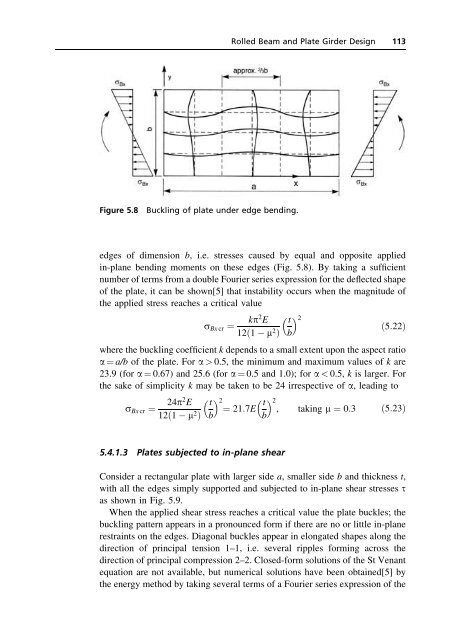The Design of Modern Steel Bridges - TEDI
The Design of Modern Steel Bridges - TEDI
The Design of Modern Steel Bridges - TEDI
You also want an ePaper? Increase the reach of your titles
YUMPU automatically turns print PDFs into web optimized ePapers that Google loves.
Figure 5.8 Buckling <strong>of</strong> plate under edge bending.<br />
edges <strong>of</strong> dimension b, i.e. stresses caused by equal and opposite applied<br />
in-plane bending moments on these edges (Fig. 5.8). By taking a sufficient<br />
number <strong>of</strong> terms from a double Fourier series expression for the deflected shape<br />
<strong>of</strong> the plate, it can be shown[5] that instability occurs when the magnitude <strong>of</strong><br />
the applied stress reaches a critical value<br />
sBx cr ¼ kp2 E<br />
12ð1 m 2 Þ<br />
t<br />
b<br />
2<br />
ð5:22Þ<br />
where the buckling coefficient k depends to a small extent upon the aspect ratio<br />
a ¼ a/b <strong>of</strong> the plate. For a > 0.5, the minimum and maximum values <strong>of</strong> k are<br />
23.9 (for a ¼ 0.67) and 25.6 (for a ¼ 0.5 and 1.0); for a < 0.5, k is larger. For<br />
the sake <strong>of</strong> simplicity k may be taken to be 24 irrespective <strong>of</strong> a, leading to<br />
sBx cr ¼ 24p2 E<br />
12ð1 m 2 Þ<br />
t<br />
b<br />
2<br />
¼ 21:7E t<br />
b<br />
5.4.1.3 Plates subjected to in-plane shear<br />
Rolled Beam and Plate Girder <strong>Design</strong> 113<br />
2<br />
, taking m ¼ 0:3 ð5:23Þ<br />
Consider a rectangular plate with larger side a, smaller side b and thickness t,<br />
with all the edges simply supported and subjected to in-plane shear stresses t<br />
as shown in Fig. 5.9.<br />
When the applied shear stress reaches a critical value the plate buckles; the<br />
buckling pattern appears in a pronounced form if there are no or little in-plane<br />
restraints on the edges. Diagonal buckles appear in elongated shapes along the<br />
direction <strong>of</strong> principal tension 1–1, i.e. several ripples forming across the<br />
direction <strong>of</strong> principal compression 2–2. Closed-form solutions <strong>of</strong> the St Venant<br />
equation are not available, but numerical solutions have been obtained[5] by<br />
the energy method by taking several terms <strong>of</strong> a Fourier series expression <strong>of</strong> the


